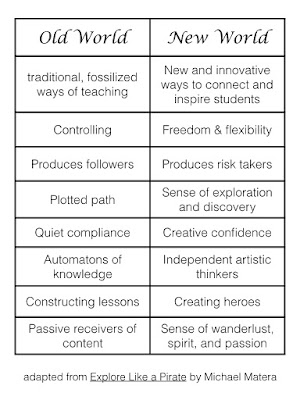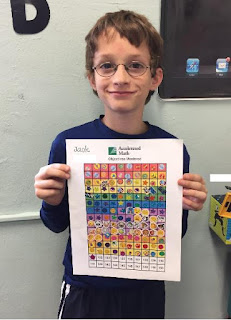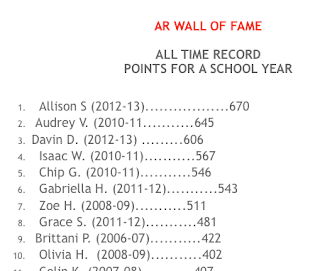For this set of posts, I am sharing how I plan to gamify my classroom this school year. You may or may not have heard of the term gamification but I can tell you that it is a philosophy that is very popular in education (and business) right now. It might be said, that with the current Pokemon Go game phenomenon, that games in general are the hot topic of the day.
What is Gamification?
It is probably necessary to define what both gamification is and is not. Gamification expert Michael Matera who wrote the excellent book Explore Like a Pirate: Gamification and Game Inspired Course Design to Engage, Enrich, and Elevate defines gamification as “applying the most motivational techniques of games to non-game settings, like classrooms.” (Matera, 9)
Many people think gamification means simply playing educational games in classroom. While playing games to learn can be part of it, gamification is far more than that. In truth, gamification of the classroom makes your entire learning experience part of the game. It unlocks natural student motivation by finding meaning in everyday learning. It can be high tech or low tech. It can encourage both friendly competition and/or collaboration. In essence, gamification uses the successful mechanics and psychology leveraged by games to encourage growth in students as they progress through their learning.
Why use games to learn?
The answer to this is simple – games are highly motivating. Games encourage persistence and a growth mindset. When it comes to games, it is also important to think about how the culture of school and learning is changing in today’s classroom. Traditionally, schools rewarded compliance and treated the teacher as the knower of all that mattered. In today’s world, students have access to any bit of information they could ever want with the click of a button. The primary role of the modern teacher should be to guide student learning. Matera uses the chart below to illustrate this change.
As educators, we strive to cultivate self-motivated, lifelong learners. And to do this, we need to tap into students’ natural motivations and, as I like to say, put the fun back into the fundamentals. Kids and adults alike love to play games. Many even sheepishly will admit becoming “addicted” to their favorite games (Candy Crush anyone?). Imagine if we could tap into this same natural motivation for the purposes of learning. How powerful would that be?
Understanding what motivates our students
Researchers have made the effort to better understand gaming and what makes it so attractive to users. Author Richard Bartle has developed a gaming theory which he classified gamers into four categories: achievers, socializers, explorers and killers. By recognizing each gamer type in your classroom will you better understand what motivates these varied groups to learn.
Types of Gamers
Achievers
“Achievers are the players who strive to gain points, levels, and items that can be measured against other players of the game to show levels of mastery” (Matera, 55). These are often self-driven learners motivated by prestige and status. They like their name posted in the class newsletter when they make accomplishments. They like their name at the top of a leaderboard. They like to master all of the 4th grade objectives like the student below.
I grew up in the 80’s when some of the first commercial video games like Pac Man and Donkey Kong first came out. Kids my age would play these games obsessively for hours and hours in the mall just so they could enter just their three letter initials at the top of the leaderboard. Similarly, achievers like small, daily competitions and awards like stickers, badges, certificates, leaderboards and other awards as recognition of their accomplishments.
In my classroom we play lots and lots of mini games like Kahoot, Quizizz, and Classroom Jeopardy to review what we have learned. I even wrote a separate post about some of my favorite high and low tech ways that I review in class.
When I still taught Language Arts I kept a leaderboard for independent reading that had motivated my top readers in my classroom for years. It seemed like every year a new student would top the previous high score, and then each year I would think to myself, nobody is ever going to break that record. And often, the very next year a student would challenge themselves and do just that. My Achievers each year always wanted to be at the top, to be #1. Some would come back to my classroom years later and ask me, “Am I still on the leaderboard?”
Socializers
Another of Bartle’s gamer categories is the “Socializer”. Socializers prefer the “social aspects of gameplay rather than the actual gameplay because they derive most of their enjoyment from the interactions with other players.” (Matera, 55) In the game world this would probably apply to social games like World of Warcraft, Minecraft, and Call of Duty where individuals can work together to either either create new environments or work toward a common goal. In the classroom, the Socializers are not just your chatty-Kathy types, but are often the students who can be used to bond and foster positive interactions in your classroom. These students like to work in teams and feel great satisfaction from accomplishing goals with others. These students gain status and satisfaction from helping others, too.
Explorers
“Explorers” are the gamers who like to dig around in a game. They like creating their own worlds, exploring at their own pace, and discovering hidden elements (sometimes called Easter eggs). This category would apply to my son who when hiking with us we have nicknamed him “the wanderer.” He loves to tinker. He loves to ask, “What would happen if I did this?” He is great at finding glitches in games and at finding hidden secrets left there by the game designers. Explorers are less concerned than the achievers with mastery or acknowledgement, but enjoy the discovery process on its own merits.
Killers (Griefers)
The unfortunately termed “Killers” are also sometimes called “Griefers” or “Conquerors.” These players enjoy playing the “bad guy” and enjoy the cost-benefit of attacking. For example, whereas the Achievers or Adventurers may enjoy working several hours to earn or find a special sword in a game, the Griefer knows that he or she can earn that sword more easily by beating you in a battle. While the nature of this role sounds negative, these players can be some of the early game adopters. They become highly protective of their group and will add enthusiasm to the game. Griefers are motivated by power and control and love collecting items that can be used to help them in this way.
What rewards are motivating for students?
The final thing I will share about gamification theory that I learned from Matera’s book is called the SAPS Model. This was based on author Gabe Zichermann’s book on the topic of leveraging the power of game mechanics, not just in schools but also in business. SAPS is an acronym for categories of motivation. They are: Status, Access, Power, Stuff.
Status
In education, and perhaps society in general, we have seen a bit of a pendulum swing against status, or acknowledgement of achievement. We have kind of become a culture where “everyone gets a trophy” so to speak. Matera suggests, and I agree with him, that status does have a place in the classroom. It should not be a problem to post or praise exemplary work by students in fear of leaving some students out. For example, in my classroom I often post a picture to the Class Dojo “class story” when students win at one of our review games. The students (and parents) love this acknowledgement.
Access
Access means allowing students to participate in something special based on certain conditions or accomplishments. Matera suggests that students can be highly motivated to gain experiences they didn’t have before. In the video game world this might be in the form of bonus or secret levels. In school, it might involve students being involved in a special reward day activity for completing certain tasks. He also suggests that it is okay if not every student experiences this aspect of the game as long as it is not tied directly to necessary learning. In our grade level, we do this with weekly Battleball (dodgeball) games. Students who earn 85% or better positive points in Class Dojo earn access to this weekly. In my classroom, we also did this in the form of a Minecraft/technology party at the end of the year. Students who met goals for mastery all of their 4th grade math standards earned this special reward.
Power
Power means that students earn agency. This means the ability to make choices or gain control over some aspect of their game. In my classroom, I do this after first having students complete something which will show me they understand the essential concept. After the student has completed this essential task, then they are given the power or agency to choose a follow-up activity which will hopefully further support their learning, but possibly in a more fun format.
Stuff
Stuff is probably the most popular of all of the motivators that are used in school. Think pizza parties, candy, trinkets, etc.. Studies have shown that extrinsic rewards such as these are actually the least rewarding of the four motivators and despite this, they are the most commonly used by teachers.
So how do I plan on gamifying my classroom this year? Read Post #2 -Playful Learning: Fostering Friendly Competition
For more on the topic of gamification, check out these great books:












